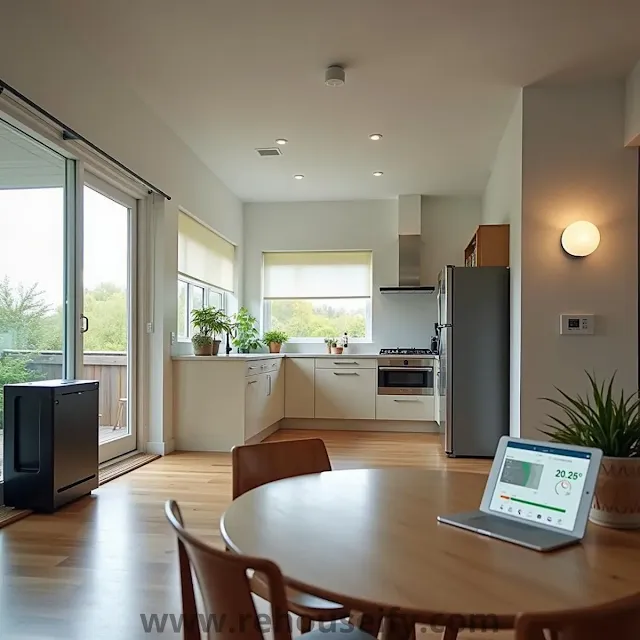 |
| Home Automation Systems |
How Home Automation Systems Can Transform Your Energy Efficiency and Save You Money
Imagine leaving home in a rush, only to realize later that you might have left the air conditioning running or forgotten to turn off the lights. In the past, such oversights would result in wasted energy and higher bills. Today, thanks to home automation systems, you can check and control your home's energy consumption with just a few taps on your smartphone—no matter where you are.
Home automation isn’t just about convenience; it’s about creating a smarter, more sustainable home. These systems empower you to monitor and optimize your energy usage, reducing costs while making your living space more eco-friendly. Let’s explore how this innovative technology can transform the way you manage energy.
What Are Home Automation Systems?
Home automation systems are interconnected networks of smart devices that communicate with each other to manage various aspects of your home. These systems allow you to control appliances, lighting, climate, and more from a central app or hub. Whether you’re at work, on vacation, or lounging at home, automation ensures that your energy usage is always optimized.
These systems often include features like real-time energy monitoring, remote accessibility, and the ability to program devices based on your daily routines. Over time, they learn your habits and make automatic adjustments, ensuring maximum efficiency with minimal effort.
Key Components of an Energy-Efficient Smart Home
1. Smart Power Strips
Smart power strips are an upgraded version of traditional power strips, designed to reduce phantom energy consumption. They automatically cut power to devices that are in standby mode, such as televisions or gaming consoles, saving energy without any extra effort on your part.
2. Advanced Home Energy Monitors
These devices provide detailed insights into your home’s energy usage, breaking it down by appliance or system. Advanced energy monitors can alert you to unusual spikes in consumption, helping you identify and address inefficiencies immediately.
3. Intelligent Ventilation Systems
Smart ventilation systems monitor air quality and temperature in real-time, automatically adjusting airflow to maintain comfort while reducing energy use. They can also work alongside smart HVAC systems to optimize overall efficiency.
4. Connected Kitchen Appliances
Smart refrigerators, ovens, and dishwashers are designed to use energy efficiently and can be scheduled to operate during off-peak hours. For example, a smart refrigerator can adjust its cooling cycles based on usage patterns, ensuring it doesn’t overwork unnecessarily.
5. Dynamic Lighting Solutions
Beyond simple scheduling, dynamic lighting systems can adapt to natural light levels, occupancy, and even your daily activities. For instance, lights in your living room can dim automatically during movie time or brighten when you’re reading.
6. Battery Storage Systems
Paired with renewable energy sources like solar panels, smart battery storage systems optimize when energy is stored and used. This ensures that excess energy generated during the day is saved for nighttime use, reducing dependence on the grid.
7. Leak Detection Sensors
While primarily focused on water conservation, leak detection sensors also contribute to energy efficiency by preventing water heater overuse caused by leaks. Early detection saves both water and the energy required to heat it.
How Automation Saves You Money
Lower Energy Bills
The most immediate benefit of home automation systems is the reduction in utility costs. By optimizing how and when energy is used, homeowners often see a noticeable drop in their monthly bills. For instance, automating your thermostat and lighting can save you hundreds of dollars annually.
Reduced Maintenance Costs
Smart systems can detect potential issues early, such as a malfunctioning HVAC system or an appliance consuming excessive energy. By addressing these problems before they escalate, you can avoid costly repairs and extend the lifespan of your devices.
Increased Home Value
Smart homes are in high demand. Prospective buyers are often willing to pay a premium for homes equipped with energy-efficient automation systems. Investing in smart technology not only saves money while you live there but also boosts your home’s resale value.
Getting Started with Home Automation
1. Start Small
2. Choose Compatible Devices
3. Monitor Progress
Real-Life Savings in Action
Case Study: The Johnson Family
After installing a smart thermostat and automated blinds, the Johnsons saw a 20% reduction in their monthly energy bills. They programmed their thermostat to lower the heat while they were at work and relied on natural sunlight to warm their home during the day. Over a year, they saved over $300 on utilities.
The Future of Energy Efficiency
As technology continues to advance, home automation systems will become even more sophisticated. AI-powered energy management tools and renewable energy integrations are already on the horizon, promising even greater savings and sustainability.
By investing in smart home technology today, you’re setting yourself up for long-term financial and environmental benefits. The journey to an energy-efficient future starts with small, smart steps. Why wait? Take control of your energy usage and start saving now.

